|
|
 |
|
|
Tropic Lightning: America’s 25th Infantry Division in Vietnam
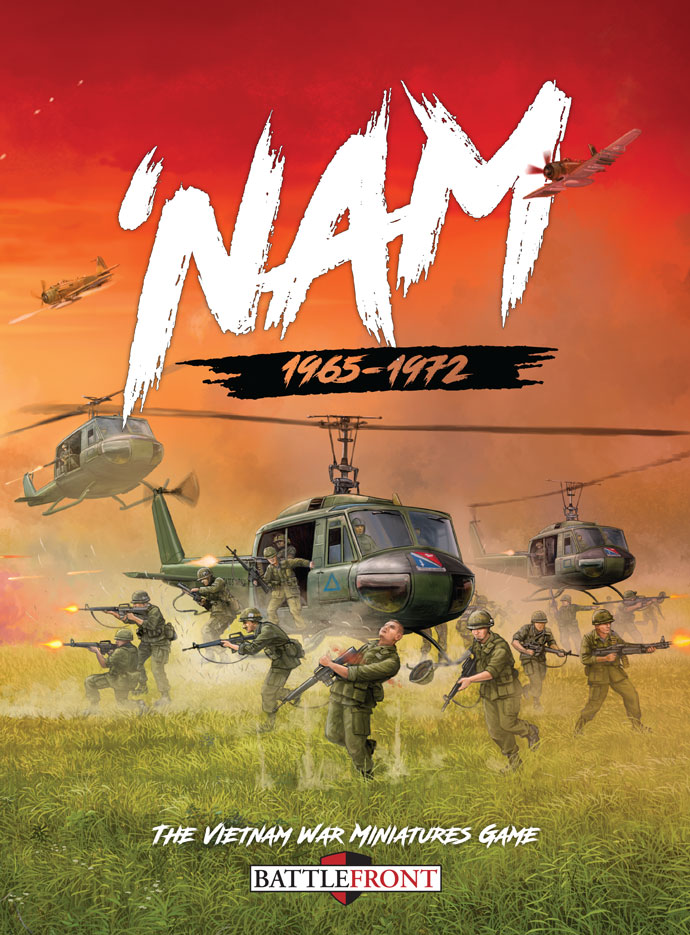 |
Tropic Lightning:
America’s 25th Infantry Division in Vietnam
by Dave Wiggins
The 25th Infantry Division ‘Tropic Lightning’ was one of the first American divisions to serve in Vietnam and one of the last to leave. In nearly seven years of combat, the division fought in every major battle around the South Vietnamese capital of Saigon. Their mechanised and armoured units proved invaluable in locating and destroying an elusive guerilla foe and defeated every major North Vietnamese offensive.
The 25th Infantry Division ‘Tropic Lightning’ was formed from elements of the Army’s Hawaiian Division on 1 October 1941 at Schofield Barracks, Hawaii. Only two months later, both the 24th and 25th Infantry Divisions achieved the distinction of being the first US Army units to see combat in World War II when the Japanese attacked military installations in Hawaii on 7 December. |
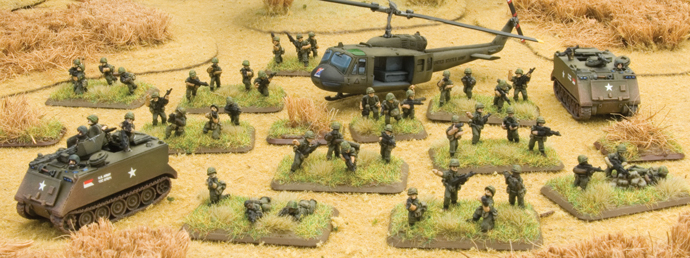 |
The Pacific War
After nearly a year of intense training in jungle warfare tactics, the division embarked for Guadalcanal in November 1942 to relieve the 1st Marine Division. It was during the heavy fighting on Mount Austin in January 1943 that the Division earned its nickname, ‘Tropic Lightning’. After leaving Guadalcanal, the Division participated in operations to secure the remaining islands in the Northern Solomons chain, including heavy fighting on New Georgia. After nearly a month of facing tenacious Japanese resistance and an unforgiving jungle, New Georgia was declared secured. The division continued operations in the Solomons until September 1943. |
Oliver Stone’s Platoon
The screenwriter and film director Oliver Stone based his film Platoon around some of his experiences while
a soldier with Tropic Lightning and 1st Cavalry Division in Vietnam in 1967 and 1968.
Stone was awarded a Bronze Star for his part in the New Years Day Battle at Fire Base Burt, and a Purple Heart with an Oak Leaf Cluster for two wounds in combat. |
| After a period of refitting and training in New Zealand, the division landed at Luzon in the Philippines in January 1945 on the left flank of the Sixth Army’s drive to Manila. After destroying the bulk of the Japanese armour on Luzon, the 25th participated in some of the fiercest fighting of the Pacific War - the hill-by-hill and pass-by-pass advance through the Caraballo Mountains. In what could be considered a foreshadowing of battles to come in Vietnam, the division contended with constant ambushes and elusive, well-dug-in enemy defenders. In 165 days of continuous combat, it suffered more casualties than any other Sixth Army division. During the war, six soldiers of ‘Tropic Lightning’ were awarded the US’s highest award for valour, the Medal of Honor. |
Korean War
The division was stationed in Japan on occupation duty when North Korea launched its surprise invasion of South Korea on 25 June 1950. The division was ordered to Korea on 5 July, and by 20 July, it was engaged in its first significant combat at Yechon. There it routed a sizeable North Korean force and achieved what was considered to be the first major ground combat victory by American forces. The 25th Infantry Division was a key factor in first holding, then later breaking out of, the Pusan perimeter and advancing to link up with forces of the Inchon landings. In thirty-six months of combat in Korea, the division was always regarded as a tough, capable unit, and another fourteen of its soldiers were awarded the Medal of Honor.
To Vietnam
After over a decade of Cold War duty and various reorganisations, the 25th Infantry Division was called to combat duty again in 1965. This time the destination was Vietnam. The division’s 3rd Brigade and 1st Battalion, 69th Armor arrived at Pleiku as part of Operation Blue Light—the first wave of the US Army into Vietnam and the largest airlift of US ground forces up to that time. The brigade quickly found itself in heavy fighting along the Cambodian border where it was joined by the bulk of the 4th Infantry Division. |
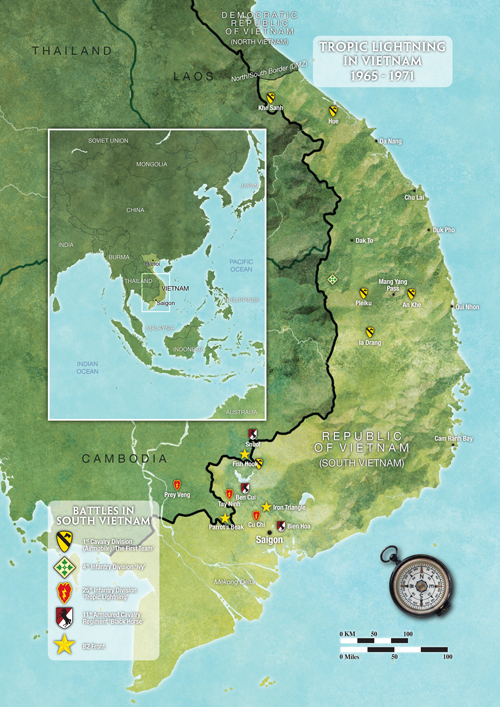 |
The rest of Tropic Lightning arrived at Cu Chi, the division’s ‘home’ in Vietnam for the duration of the war, near Saigon in January 1966. There they adopted the 3rd Brigade of the 4th Infantry Division to replace their own missing 3rd Brigade, although it would not be until August 1967 that the swap was made permanent.
The 25th Infantry Division was a mechanised force with three mechanised infantry battalions mounted in M113
armoured personnel carriers, one in each brigade, a tank battalion with M48 Patton tanks, and a cavalry squadron with M113 ACAV Armoured Cavalry Assault Vehicles. On top of this, both the 1st and 3rd Squadrons of the famous 11th Armored Cavalry Regiment (‘Blackhorse’) were also attached to the division for some operations. |
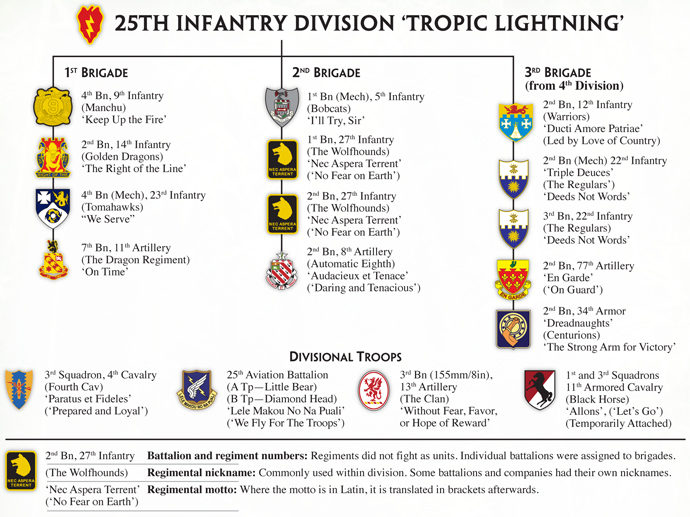 |
The Iron Triangle
The division’s missions consisted of fighting in terrain that was hardly suited to conventional mechanised operations, and Tropic Lightning, and the Army as a whole, had to adapt both equipment and tactics to this environment. Dr Ronald Glasser who treated the division’s wounded describes the 25th Infantry Division’s assigned area, the well-known ‘Iron Triangle’, and its role:
"The headquarters for the 25th Division lay forty miles northwest of Saigon, in the foothills of the central highlands. The Army had placed it astride one of the major infiltration routes from Cambodia; part of the protective arc offered up to Saigon by the 9th Division in the Delta, the 25th, based on Cu Chi, and the Americal and the 1st Division farther north. During the dry season, the land the 25th worked reached from the impenetrable jungle, triple canopied, in the west to rice paddies in the south and north. During the monsoons, the jungle became wet and the paddies impassable, but it was dry now; the jungle was burning off and the paddies were rock-hard." |
 |
After arriving at Cu Chi, the Division had to contend with the vast and still active tunnel complex of Cu Chi, literally in its own backyard. The tunnels had been targeted by US and Australian forces during Operation CRIMP in 1966, and despite much of the complex being destroyed, the tunnels had remained an active and important resource for the enemy. The tunnel complexes in the Iron Triangle proved especially challenging to the division’s mechanised units. As one soldier put it:
"They’ve had twenty years of making tunnels—all over the area—all over Nam, I guess. Sometimes they go down deep; sometimes they’re near the surface. When they get near the surface like this one, they run them parallel to where they think we might be going. All you have to do is punch a hole out of the side, lie there with your RPG, and when a track comes by or a squad, BAMB!"
Despite the challenges posed by jungle, rugged terrain, paddies, and monsoons that turned dirt roads into muddy quagmires, the mechanised, armour, and cavalry forces played a vital role in US strategy throughout the war. Along with the UH-1 helicopter, the M113 armoured personnel carrier became an iconic image of the Vietnam War. |
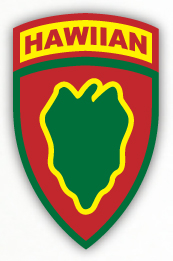 |
From Taro Leaf to Electric Strawberry:
The Many Names of Tropic Lightning
The 25th Infantry Division, ‘Tropic Lightning’, and its sister 24th Infantry Division were formed in 1941 from the US Army’s Hawaiian Division rounded out with units from the Hawaii and Washington National Guard.
The Hawaiian Division’s insignia featured the Taro leaf (a native plant of Hawaii used to make poi, a staple
Hawaiian dish, and the symbol of Hawaii). The 24th Infantry Division adopted this insignia with a few modifications, but the 25th was not given an insignia of its own. |
On Guadalcanal, the headquarters of the 25th Infantry Division adopted the call sign ‘Lightning’ for operational security since the Japanese had trouble pronouncing the letter ‘l’. The division quickly became known as ‘the Lightning Division’ for the aggressive way it conducted combat operations and the rapid conclusion of its mission. Later, the division became known as ‘Tropic Lightning’ and this became its nickname.
On 7 June 1944 (the day after D-Day in Europe), Tropic Lightning finally got its own distinctive insignia: a Taro leaf to indicate its ties to the old Hawaiian Division, in the colours of the Hawaiian monarchy, red and gold, with a lightning bolt superimposed. |
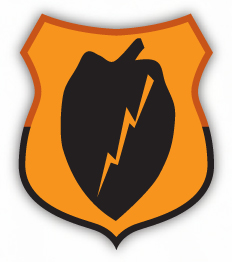 |
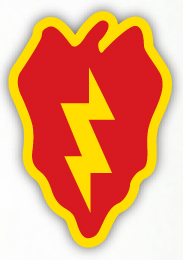 |
In Vietnam, Tropic Lightning received two new nicknames. The first of these, ‘the Cu Chi National Guard’ referred to the division’s base at Cu Chi, and the fact that the division was stationed there for the duration of the war—unlike other divisions that tended to periodically relocate to new assignment areas.
The psychedelic Sixties was the source of the division’s second nickname in Vietnam, ‘Electric Strawberry’. This nickname was actually used as an unsanctioned radio call sign on occasion.
For all this, ‘Tropic Lightning’ remains the 25th Infantry Division’s most recognized (and official) nickname. |
Operations in Vietnam
From 1966 to 1970, the Division’s main area of operations was the area north and west of Saigon where it repeatedly fought North Vietnamese Army and Viet Cong units in the Iron Triangle area. In November of 1966, the Division was involved in the largest ground operation of the war up to that time, Operation Attleboro, the first ‘Zippo’ or Search and Destroy mission. After six weeks of fighting virtually destroyed the 9th Viet Cong Division (one of the three B2 Front Main Force divisions) and captured enormous quantities of enemy supplies at a cost of 155 killed and 494 wounded.
Early 1967 saw the Division again engaged in major combat in Operations Cedar Falls and Junction City. The
largest Search and Destroy operation to date in the war, Cedar Falls was intended to remove the enemy from the
Ho Bo Woods area of the Iron Triangle and to destroy the tunnel complexes once and for all. During Cedar Falls, the Division served as the anvil against the hammer of the 1st Infantry Division, clearing the area in nineteen days at a cost of 72 Americans killed. The Ho Bo Woods operational area never again saw a significant enemy presence for the remainder of the war. |
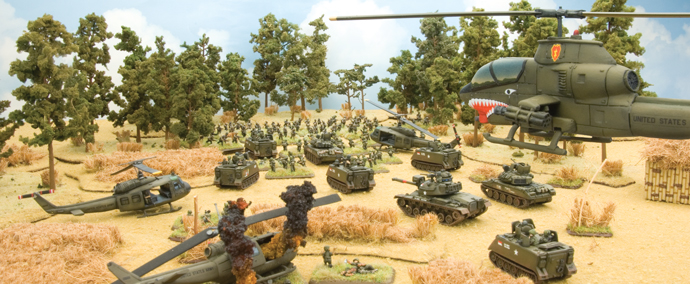 |
The tunnel complex, however, was not completely neutralized and it continued to remain a problem for the division. The surviving tunnels were used as a staging area for the attack on Saigon during the 1968 Tet Offensive. The division’s mechanised and tank battalions played a vital role during the Tet Offensive. Their mobility allowed them to rapidly respond to the many widespread attacks throughout the Division’s area of responsibility. During the Tet Offensive, the Division was instrumental in successfully defending Tan Son Nhut Air Base and Saigon itself.
Later that summer, in operations in Cambodia and around Tay Ninh city North West of Saigon, the division
inflicted over 2,000 casualties on the enemy and almost completely destroyed eight PAVN regiments. Indeed, the Tropic Lightning Division always defeated any enemy unit if faced, and the litany of engagements from its service in Vietnam reads like a list of many of the war’s famous battles: Cedar Falls, the Iron Triangle, Cu Chi, the Ho Bo and Boi Loi Woods, Tay Ninh, War Zone C, Ben Cui and Cambodia. In one of the division’s proudest moments, it successfully defended Fire Support Base Buell for four days and nights, often fighting at point-blank range. All told in Vietnam, the division served in combat for 1,716 days, participated in twelve campaigns, and once again received numerous awards. Twenty-one soldiers were awarded the Medal of Honor and 4,561 Tropic Lightning soldiers were killed. |
 |
Post Vietnam
Since the end of the Vietnam War, the 25th Division has been anything but idle, and ‘Tropic Lightning’ continues to be a premier division of the US Army in the 21st Century. It has participated in numerous deployments and exercises throughout the Pacific region, and in peacekeeping operations in the Sinai and Bosnia (the first time the division served in Europe). Most recently, the division has participated in prolonged combat operations in both Iraq and Afghanistan. The division continues to be an active, capable, and enormously successful combat unit, and will certainly remain a key part of the US Army in the future. |
Last Updated On Thursday, July 13, 2023
|
|
|